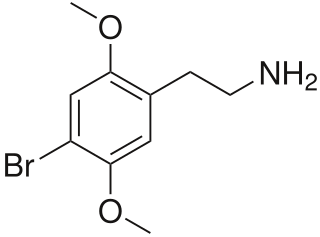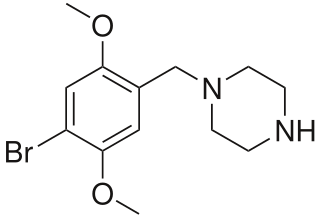
2C-B (4-bromo-2,5-dimethoxyphenethylamine) is a synthetic psychedelic drug of the 2C family, mainly used as a recreational drug. The substance was first synthesized by Alexander Shulgin in 1974, and gained an initial reputation for potential psychotherapeutic use, but its use has been limited to mainly recreational use. To date, there is limited scientific information regarding the drug's pharmacokinetics and pharmacological effects in humans. The existing studies primarily classify 2C-B as a stimulant, and hallucinogen, and less commonly as an entactogen, and empathogen.

2C-T-2 is a psychedelic and entactogenic phenethylamine of the 2C family. It was first synthesized in 1981 by Alexander Shulgin, and rated by him as one of the "magical half-dozen" most important psychedelic phenethylamine compounds. The drug has structural and pharmacodynamic properties similar to those of 2C-T-7.

2C-B-FLY is a psychedelic phenethylamine and designer drug of the 2C family. It was first synthesized in 1996 by Aaron Monte, Professor of Chemistry at UW-La Crosse.

4-Bromo-2,5-dimethoxy-1-benzylpiperazine (2C-B-BZP) is a psychoactive drug and research chemical of the piperazine chemical class which has been sold as a "designer drug". It produces stimulant effects similar to those of benzylpiperazine (BZP).

2CBFly-NBOMe is a compound indirectly derived from the phenethylamine hallucinogen 2C-B, and related to benzodifurans like 2C-B-FLY and N-benzylphenethylamines like 25I-NBOMe. It was discovered in 2002, and further researched by Ralf Heim at the Free University of Berlin, and subsequently investigated in more detail by a team at Purdue University led by David E. Nichols. It acts as a potent partial agonist for the 5-HT2A serotonin receptor subtype.

2,5-Dimethoxy-4-fluoroamphetamine (DOF) is a psychedelic drug of the phenethylamine and amphetamine classes. Alexander Shulgin briefly describes DOF in his book PiHKAL:
Animal studies that have compared DOF to the highly potent DOI and DOB imply that the human activity will be some four to six times less than these two heavier halide analogues.

4-Substituted-2,5-dimethoxyamphetamines (DOx) is a chemical class of substituted amphetamine derivatives featuring methoxy groups at the 2- and 5- positions of the phenyl ring, and a substituent such as alkyl or halogen at the 4- position of the phenyl ring. Most compounds of this class are potent and long-lasting psychedelic drugs, and act as highly selective 5-HT2A, 5-HT2B, and 5-HT2C receptor partial agonists. A few bulkier derivatives such as DOAM have similarly high binding affinity for 5-HT2 receptors but instead act as antagonists, and so do not produce psychedelic effects though they retain amphetamine-like stimulant effects.

2CB-Ind is a conformationally-restricted derivative of the phenethylamine hallucinogen 2C-B, discovered in 1974 by Alexander Shulgin. It acts as a moderately potent and selective agonist for the 5-HT2A and 5-HT2C receptors, but unlike the corresponding benzocyclobutene derivative TCB-2 which is considerably more potent than the parent compound 2C-B, 2CB-Ind is several times weaker, with racemic 2CB-Ind having a Ki of 47nM at the human 5-HT2A receptor, only slightly more potent than the mescaline analogue (R)-jimscaline.
Ritz ballistic theory is a theory in physics, first published in 1908 by Swiss physicist Walther Ritz. In 1908, Ritz published Recherches critiques sur l'Électrodynamique générale, a lengthy criticism of Maxwell-Lorentz electromagnetic theory, in which he contended that the theory's connection with the luminiferous aether made it "essentially inappropriate to express the comprehensive laws for the propagation of electrodynamic actions."

βk-2C-B is a novel psychedelic substance. It is the beta (β) ketone structural analogue of 2C-B, a psychedelic drug of the 2C family. It is used as a recreational drug, usually taken orally. βk-2C-B is a controlled substance in Canada, Germany, Switzerland, and the United Kingdom.

25B-NBOH is a derivative of the phenethylamine derived hallucinogen 2C-B which has been sold as a designer drug. It acts as a potent serotonin receptor agonist with similar affinity to the better-known compound 25B-NBOMe at 5-HT2A and 5-HT2C receptors with pKis values of 8.3 and 9.4, respectively.

2,5-Dimethoxy-4-isopropylamphetamine is a psychedelic drug of the phenethylamine and amphetamine chemical classes. It was first synthesized by Alexander Shulgin, and was described in his book PiHKAL. Shulgin described DOiPR as being at least an order of magnitude weaker than DOPr, with doses of 20–30 mg required to produce valid changes in mental state. Very little data exists about the pharmacological properties, metabolism, and toxicity of DOiPR.

2C-B-BUTTERFLY is a conformationally-restricted derivative of the phenethylamine hallucinogen 2C-B, which was discovered in 1999 by Michael S. Whiteside and Aaron Monte. It is a ring-expanded homologue of the better known compound 2C-B-FLY, and has similar properties as an agonist for serotonin receptors, but with more selectivity for 5-HT2C over 5-HT2A.

The substituted benzofurans are a class of chemical compounds based on the heterocyclyc and polycyclic compound benzofuran. Many medicines use the benzofuran core as a scaffold, but most commonly the term is used to refer to the simpler compounds in this class which include numerous psychoactive drugs, including stimulants, psychedelics and empathogens. In general, these compounds have a benzofuran core to which a 2-aminoethyl group is attached, and combined with a range of other substituents. Some psychoactive derivatives from this family have been sold under the name Benzofury.

25B-NBF is a derivative of the phenethylamine hallucinogen 2C-B, which acts as a highly potent partial agonist for the human 5-HT2A receptor.

4C-B is a lesser-known psychedelic drug which is related to 2C-B and DOB. It is a reasonably potent 5-HT2A receptor partial agonist with a Ki of 7.6nM, but has relatively low efficacy. It is briefly mentioned in Alexander Shulgin's book PiHKAL but was never tested by him, however it has subsequently been tested by other researchers and was found to be active in a dose range of 50-80mg with a duration of around 8 hours, though with generally milder effects than 2C-B or DOB.

2C-T-3 is a lesser-known psychedelic drug related to compounds such as 2C-T-7 and 2C-T-16. It was named by Alexander Shulgin but was never made or tested by him, and was instead first synthesised by Daniel Trachsel some years later. It has a binding affinity of 11nM at 5-HT2A and 40nM at 5-HT2C. It is reportedly a potent psychedelic drug with an active dose in the 15–40 mg range, and a duration of action of 8–14 hours, with visual effects comparable to related drugs such as methallylescaline.

N-Benzyl-2C-B is a recreational designer drug from the 25-NB subgroup of the substituted phenethylamine family, with psychedelic effects. It has a binding affinity (Ki) of 16 nM at the serotonin receptor 5-HT2A and 90 nM at 5-HT2C and reportedly has a potency in between that of 2C-B and NBOMe-2C-B.

















